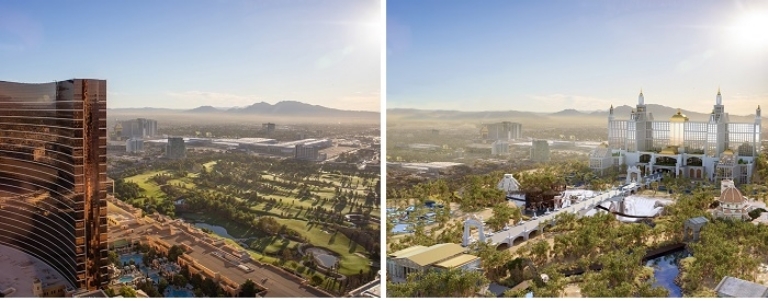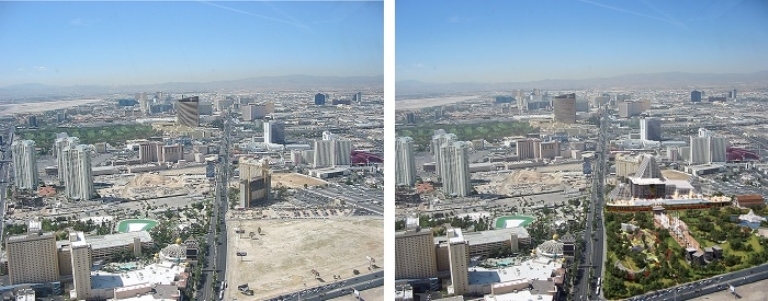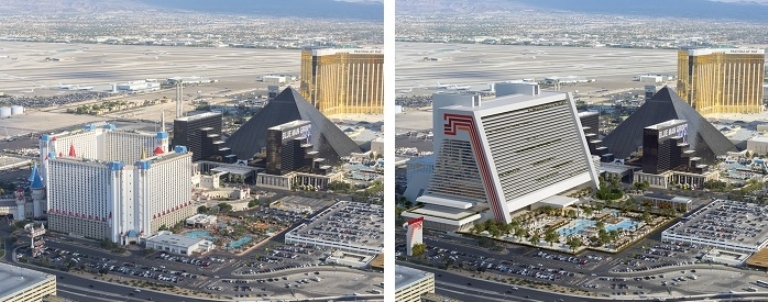

These are some of the resort projects that were announced but never developed. Like everything else in Las Vegas, they were great ideas, but they faced obstacles, financial or bureaucratic, to be carried out.
Four of these never-built hotels and casinos on the Strip, the city's main thoroughfare, were recreated by the Viva Lost Vegas project, conceived by Betvictor.com, a UK-based gambling site. Based on the projects published at the time, the website's team helped to imagine what the city would be like with these resorts.
Then, O Globo puts together a before and after, with images that compare the current locations with others that show what they would be like if the projects had come off the paper.
Desert Kingdom

In 1997, Las Vegas hoped to win what should have been the grates of its resorts. The project, then budgeted at US$750 million, promised to revolutionize the city. And who was behind it was one of the largest hotel groups in the United States at the time, the ITT Sheraton.
The idea was to transform The Desert Inn, one of the most traditional resorts in Vegas (the fifth to open on the Strip in 1950), into a kind of idyllic kingdom, with a sumptuous Bali-inspired palace, with 3,500 rooms and nine restaurants, sumptuous gardens and a system of canals that could be traversed by boat. This water ride would pass under the 12,500 square meter casino and end in a beautiful lagoon, stage of a nightly light and water show.
But over the course of the 1990s, some facts got in the way of that plan. The main one was the acquisition of the Sheraton group by another, Starwood. Now within a much larger corporation, the project was forgotten. In 2000 the Desert Inn was sold to developer Steve Wynn, and the following year it was imploded to make way for the towers of the current Wynn and Encore hotels. Today, from the top of these two golden towers, the guest sees the space that should have been a desert kingdom.
London Hotel & Casino

How far are the pyramids from Egypt to the English Parliament? In the real world, it's just over 5,500 kilometers. But in the fantastic world of Las Vegas, it could be a few feet. That's if the London Resort had gotten off the ground.
The complex, which would be next to the Luxor (the pyramid) and Mandalay Bay resorts, would have replicas of several London icons, such as Big Ben, Tower Bridge, and the Tower of London, as well as the Parliament. The complex would house more than 2,000 hotel rooms and an 8,362 square meter casino. And also a Ferris wheel inspired by the London Eye. The shopping center, inspired by the neighborhoods of London, would have 51,000 square meters, and would have a megastore of the department store Harrod's.
Over the years, however, the project has passed from hand to hand, and has already been planned for several points on the Strip. But it hasn't come out of the paper yet.
The Titanic

A resort shaped like the Titanic would be the face of Las Vegas, right? It would be if The Titanic project hadn't sunk in the desert sands of Nevada. Compatible with the grandeur of the iconic vessel that sailed from Southampton and never made it to New York, the hotel-casino would cost about US$1.2 billion, and would feature attractions such as theatre, amusement park and a zoo.
The little more than 1,200 rooms would be spread across the main building, a smaller scale replica of the ship, 121 meters tall (double what the original vessel had). The Ice Breaker nightclub would also function on-site.
Bob Stupak, renowned Las Vegas entrepreneur and creator of The Stratosphere attraction, was the mastermind of the project, presented to the City Council in 1999. Originally, the resort would be across from Sahara Las Vegas, north of the Strip, but the proposal was rejected by the authorities. A new attempt was made to relocate the development near the intersection of Las Vegas Boulevard and Charleston Boulevard, which was again denied, due to the more residential character of that region.
Xanadu

There are those who say that Xanadu would have revolutionized Las Vegas if this project, which cost US$ 150 at the time, had been carried out. First proposed in 1975, the resort had a modern, luxurious aesthetic yet unheard of on the Strip.
The project, almost a futuristic pyramid, provided for an elevated atrium, 1,730 rooms and many features that are now standard, but which were innovative at the time, such as a garage. The resort would also have a casino, a convention center, a multi-sport gym and tennis courts.
The location would be where the medieval-themed Excalibur resort stands today and far less sophisticated than Xanadu. But what went wrong? The answer gets to be prosaic, close to the project's complexity. Construction plans were put on hold when it was discovered that the city's sewage system in the 1970s could not support a project of that size.
Source: O Globo